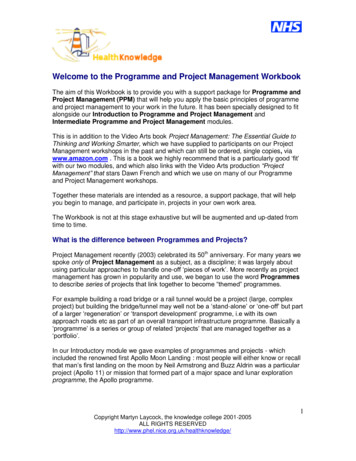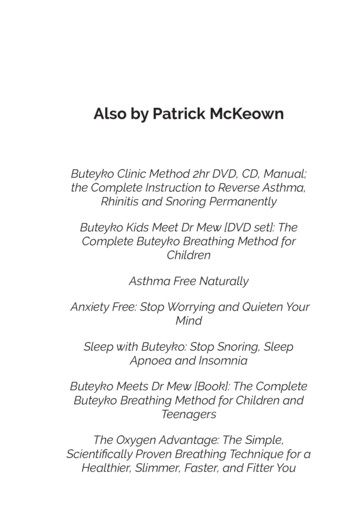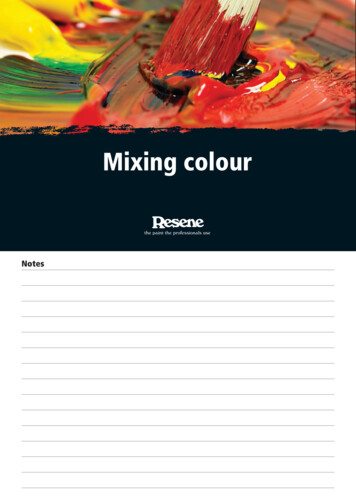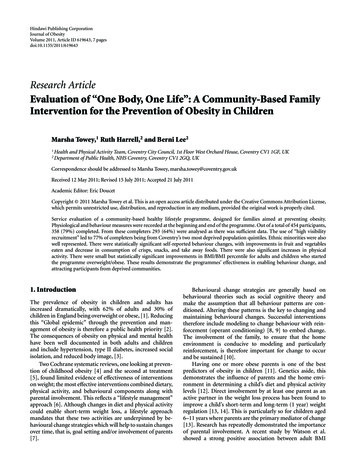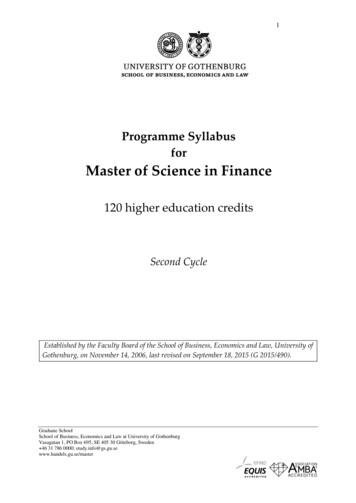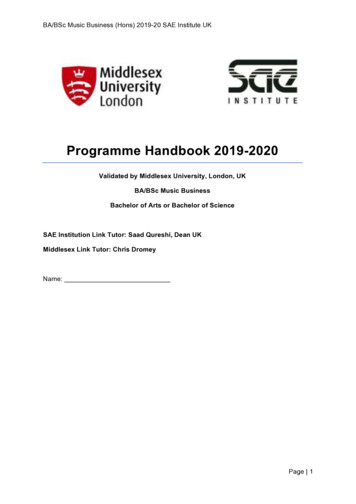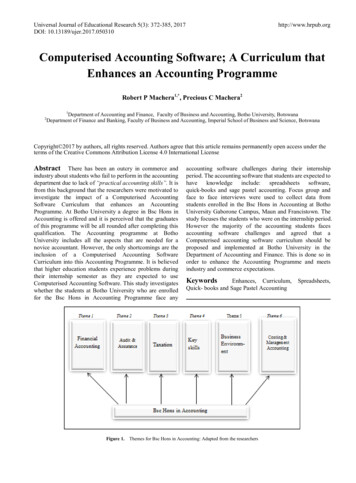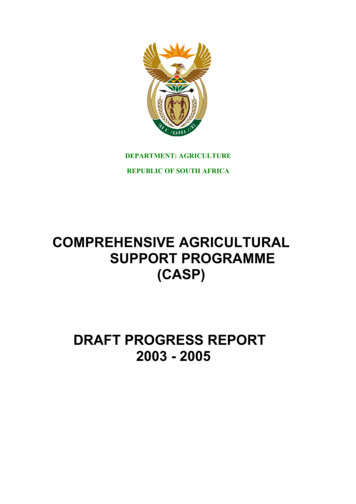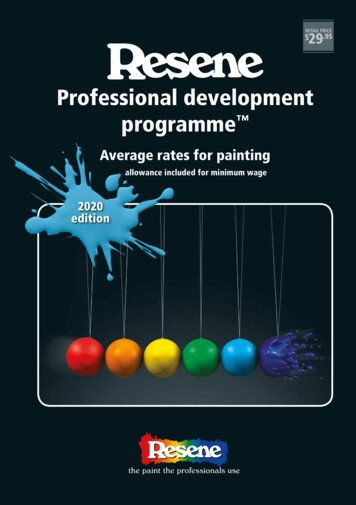
Transcription
Professional developmentprogramme Average rates for paintingallowance included for minimum wage2020edition
Resene Professional development programmeIntroductionPainting contractors mostly undertake work fortheir clients by preparing quotes that both describe,or specify, the work and fixes a price.Experience is a great teacher and some establishedpainters can and do judge their prices instinctivelyand accurately, and good on them, but carefullymeasuring and checking will always pay ahandsome dividend.The rates for common painting tasks are theaverage of many measurements of similar tasks bymany painters and will provide a basis to do yourvery best for clients, using quality materials, pay allthe bills and leave enough over for a good living.Mostly the basis of the rates is that the respectivematerials and consumables are accounted for andthe labour portion reflects approximately the upperaverage hourly rate for the painting trade.These Average rates for painting – 8th editionare maintained as a guide to the painting industryand many painters are finding the information anextremely useful companion when pricing jobs.Quoting correctly is essential – your price mustbe sufficient to enable the completion of the works,all expenses and materials paid and enough moneyleft to provide a living.Seems simple enough, but incorrect quotingdoesn’t lessen your contractual obligations tocomplete the job satisfactorily – mostly the moneymeant for living simply evaporates – your money!What customers want from painters: A good job done (performance). Fair treatment. Be reasonable and tell people what you will do and do it (reliability). That the silver will be on the sideboard at the end of the job (trust). Something good to tell their friends about (satisfaction).Make sure then that your budget will do all of the above, and remember to leave a little inthe budget for yourself.1
Resene Professional development programmeAverage costs for painting These rates are based on careful data analysisfrom many successful contractors and whileevery care has been taken please rememberthey are a guideline to use. Finally, you haveto decide how to quote your work – you maybe able to perform differently from the priceaverage indicator. All rates are exclusive of GST. The Professional development systems chartsare a useful quick reference for many commonpainting jobs. Remember customers want valuefrom painters and telling them exactly andproperly what you propose will pay dividends. The basis of costs per square metre measuredon flat and windows including glazing aremeasured flat overall. Items such as fascias,skirtings and trims are given on the basis oflineal metre 0-150mm in girth and 150-300mm. To these rates you must allow as needed:a) Scaffolding and access: These rates includeall usual painter’s access. Awkward andhigh access must be considered as required.b) Extraordinary: You may have to allow forworking at night, access permits, travellingand accommodation.c) Extra materials: Apply the rates sensiblybut check if you require really expensivewallcoverings or coating materials.Average rates for painting is an ongoing resourcefor the painting trade and your suggestions forimprovements or better solutions are welcomed –it’s easy, just email update@resene.co.nz or dropus a line.Many painters already do so because they havefound that sharing information actually provides abetter resource for everyone.Call 0800 RESENE (737 363), visit www.resene.co.nzor email us at advice@resene.co.nz2
Resene Professional development programmeThe tablesThe Measure tells us whether the particular item is a flat measure in squaremetres, or a lineal measure (length running by small widths, either up to 150mmor up to 300mm) or as described objects, such as, for convenience a door andframe or windows described as a number thereof.The Rate is the built up total of materials, and labour including allowancesfor overheads, holiday entitlements etc and some profit included, but excludingGST.Learn your costsPrice sensitivityRemember these rates are the average of painter’scosts and you must decide for yourself as to theirusefulness – the very term average (of rates)indicates some painters are both more and othersless expensive than the average figure.Have you ever noticed you can classify potentialcustomers into three groups based on theirsensitivity to price?The best results are achieved by learning all aboutyour particular costs of painting and developingthe confidence to provide your clients with pricesthat work for you – when you give a price this isthe only opportunity to get it right.Customers spending their own moneyWhen you have to pay for things out of your taxpaid income, you are usually quite careful with yourdecisions, particularly if the amount is large. Thesecustomers can be expected to be the most priceand quality sensitive of the three groups.Customers who own their own businessesPayments are tax-deductible, so business ownersspend the Government’s money as well as theirown. Their purchases are subsidised. They are alsoless price-sensitive than the first group because: Businesspeople have less time to fuss overprices; They want reliability and good service, whichsaves them administrative time.Customers spending other people’s moneyThese are the bigger organisations. Their staff willhappily pay to avoid making mistakes. This is whyso many of them call in consultants. Sell them onthe idea you can keep them out of trouble andcharge accordingly.3
Resene Professional development programmePainting by overall floor plan areaRapid Measuring Guidefor the average homeBecause the essential elements of a house are allpretty simple the idea of a rate for each squaremetre of the floorplan became common withhousing developments, particularly in Australia,and the idea spread into the painting trade,producing some very unfortunate consequences forpainters because the rate tends to decrease withtime and competition rather than increase.There are surprising regional differences in therates when comparing similar average houses (forexample) and for those engaged in work on thisbasis a simple analysis is:(FPA) x (Rate) amount of moneytake away the cost of paint and materialswhat’s left is the gross earning and this totaldivided by the time (as in number of hours) takento paint the job gives you your earning rate. If it’sless than around 50- 55 for each hour spent onthe job then the return is less than the averagewaged painter in full time employment!Many new houses are painted and decorated onthe basis of an inclusive rate per square metre ofthe floor plan.For typical new houses with three coat paintingsystems, a FPA rate for interiors only from upwardsof 55 per m2 for average three coat paintingsystems will mostly achieve this result for goodtradespeople. Lesser amounts quickly have youearning peanuts – working longer and longer hoursto make a living, and of course complete immersionin this market. Working all sorts of hours alsomakes it nearly impossible to look for alternativeand (hopefully) better painting opportunities.This amount for each square metre of the floorplangives the cost of interior decoration and the outsidepainting such as soffits, feature walls etc should beadded as additional items.By using the same basic floor plan area some otherinformation can be rapidly assembled.Using the Floor Plan Area (FPA)Interior painting Ceilings: FPA x rate per m2 Walls:(a) 2400 – FPA x 2.5 x rate m2(b) 3000 – FPA x 3 x rate m2 Doors and frames: total number x rate each Trims/window liners: FPA x 3 cost in dollarsExterior painting Roof: FPA x 1.40 (average slope) x rate m2FPA x 2 (steep or tray) x rate m2 Soffit: FPA x .14 (500 wide) x rate m2 Walls: FPA x .80 x rate m2 Base: FPA x .15 x rate m2Be careful of unit rate prices per m2 of floor plan – check all details!Many home builders, property developers and project managers offer fixed prices and/or rates for paintingwork – often at amounts less than reasonable to enable painters to make a decent living.Call 0800 RESENE (737 363), visit www.resene.co.nzor email us at advice@resene.co.nz4
Resene Professional development programmeThe business of painting differsfrom the trade of paintingLearn all you can about thesefive vital components of thebusiness of painting‘a’ to paint anything you need some paint, some tools to prepare and apply the material.This part of painting remains a constant cost and you need money to pay for this portion,so ‘a’ materials.‘b’ the time spent applying the materials and the amount you earn is the variable part ofpainting, so ‘b’ labour.‘c’ is the total costings of the business of painting and includes insurances, vehicles,telephones, stationery, fees and licences, bank charges, rent etc and is often, for smallbusinesses as much as the total of materials used. ‘c’ overheads.‘d’ is the specific cost of each project and includes such items as scaffolding, outwork,travelling accommodation etc and is particular to each job ‘d’ establishment.‘e’ profit – this amount can be increased or decreased to meet market conditions andworkloads etc.5
Resene Professional development programmeMaterial costsThe paint manufacturing industry shares dataregarding market share, material trends and overallyields among other bits and bobs – some for theirown interests and for others such as GovernmentTrade and Commerce data.From this database the painting trade paysapproximately 16 per litre for materials, and thisamount includes all products i.e. ‘top shelf’, tradelines, strong colours, textures etc etc that paintersuse within their trade.Painting the same wall using the trade ‘average’the maths are (on a 10 litre basis)160 1.33 per metre for sealer120and160 x 2 2.90 per metre for topcoats110totalling 4.23, the difference less than the retailcost of paint at 6.45 per square metre.Painters need to decide whether this differencebelongs to them or their customers – we suspectmany painters pass on their discounts to make theirprices ‘more competitive’.Much is made by painters about the cost of paint –paint is the essential material costing but the profitsin painting are with labour management. The primecost of painting in this exercise is at average tradepricing 76% labour and 24% materials.There is an opinion that some bigger paintingcontractors receive buying terms for material thatprovides a competitive advantage when quotingfor work packages. These people already areincluded in the average price for trade anywaybut would need enormous percentage marginsto appreciably alter the balances – a 10% pricereduction, equivalent to another 30% discounton paint prices reduces the cost on the wall from 4.25 to 3.38 per square metre but even withthis massive reduction 78% remains labour and22% materials.Paints that increase labour productivity have thepotential to make huge gains as opposed to pricereductions per litre. Any materials that are easierto apply or cover better/go further when appliedwill, within the average grouping of architecturalcoatings painters mostly use, make you moremoney.That painters should continue to hassle theirsuppliers for better buying terms remains adecent pastime, because price is an importantconsideration for painters and their customers but,once a reasonable commercial agreement is made,better material performance is more critical to yourbottom line.On flat wall surfaces painters mostly average120m2 per coat per day – this is each day andincludes all the mucking about contingent withthe process – masking, talking, texting, dit dit andditto! and this results in 15.50 per m2 for paintingpaperfaced plasterboard in three coats. This returnsaround 55 for each hour painting and thereforecovers the overheads and leaves a little profit.Call 0800 RESENE (737 363), visit www.resene.co.nzor email us at advice@resene.co.nz6
Resene Professional development programmeLabour calculationOrdinary time 45 hours x 24.50 . 1,102.50Add Holiday and sick leave ( 16%) .176.40ACC and First Week Liability ( 6%) .76.34Subtotal . 1,355.24Divide by Productive Hours 1355.24 43.33 .31.28(Deduct paid break time each day)Plus Brushware/rollers/consumablessupplied by employer .8.00Direct cost (@ 24.50 per hour). 39.52Add overheads ( 11 per hour) . 11.00. 50.52Add profit @10% . 5.05. 55.577
Unit ratesHour% factorMeasure rate labourmaterialsTradesperson, Journeyman, Painter per hour52.00Skilled/Foreman/Leading hand painter per hour55.00Contract supervisor self employed painter per hour60.00Service plusage to cover equipment, brushware,distribution, environmental complianceTravelling allowanceeach hourper kilometreeach personadd 60cfrom 90clabour unit ratesResene Professional development programmeApprenticesCharge apprentices at tradesperson rate per hour. Although they are training, the cost to your business issimilar to a fully trained painter.Call 0800 RESENE (737 363), visit www.resene.co.nzor email us at advice@resene.co.nz8
Resene Professional development programmeHoliday pay and sick leave calculationTotal weeks – (Including leap year)Annual holidaysStatutory holidaysSick leaveTotal non-working time Total weeksNon working weeksTotal weeks worked in year 7.20 x 100 44.94152.14 weeks4.00 weeks2.20 weeks1.00 week7.20 weeks52.14 weeks7.20 weeks44.94 weeks16% (Holiday pay and sick leave calculation)Public Liability Insurance, ACC LevyPublic Liability is usually based on taxable wages paid. 1% is allowed, but the rate will vary dependingon risk. ACC Levy is set by regulations. The employer is liable for 80% of wages for the first week ofemployment related to accidents.Public LiabilityACC Levy (example only, check current levy rates)1st week (Employer)Percentage addition for Insurance and Levies1.00%2.09%2.50%5.59%You need to earn enough from painting to allow recovery of all these statutory entitlements –lots of self employed people miss out because their charges are too low.KiwiSaverIf you ‘top up’ an employee’s savings plan remember to add the amount onto your costings – you will onlybe able to recover the contributions from your earnings from customers.9
OverheadsThese are the costs used to run your business thatare separated from the costs of the function ofpainting (paint and accessories) and are recovered(hopefully) by including an average for theoverheads in prices you give customers for work.In some regards overheads can be included, forexample – a painter’s hourly rate for charging upwill include overheads which are in the order ofone third of the total cost of labour.Similarly, the build up dollar rates for painting‘Average rates for painting’ also include anoverhead allowance, and a modest profit.Quite often the total of overheads, particularly withsmaller businesses, is rather more than the totalcosts of materials used by the business, and infact the overheads, as a percentage of productivitytends to be highest when the firm is smallest and ofcourse the percentage decreases as the productivitybase widens – a self employed painter running abusiness painting needs all the items listed andeconomies of scale would suggest that mostly theywill need for example a van and a phone, so toocould another painter employing four people – andthe same cost would be spread over the earningefforts of five people.It is a commonly expressed statement that paintingis so much more fun working away by oneself, butthese people need to be right at the high end withtheir prices to properly pay for everything.Very often painters can judge the time and materialsneeded for a job well enough and tend therefore toproduce quotes that cover the ‘time and materials’but overlook the standing overhead costs.Pretty well in every town there are two broadgroups of painters with their average prices andthe lower group consistently undervalues the costsof painting as a business while the others get itright. This despite the assertion from both groupsthat our industry is ultra price sensitive.overheadsResene Professional development programmeA typical set of overheads would be:1. Accountancy fees – usually more than expected.2. Advertising – word of mouth is best, butchances are you may need to supplement itwith some other advertising.3. Bank fees – nibble away at all of us.4. Directors’ fees – partners and sweethearts.5. Entertainment – staff shouts and Xmas etc.6. General expenses – often interesting.7. Plant and equipment hire – more particularlyestablishment costs.8. (Home) Office/workshop – legitimate expense.9. Insurances – you’ll need this for when troublestrikes.10. Interest (bank) – sometimes you need somefinance.11. Interest (H.P.) – vans and spray equipment andcomputers.12. Legal costs – best avoided!13. Postage and stationery – quite a lot on anannual basis.14. Repairs and maintenance – these are runningcosts of machinery and plant.15. Subscriptions – Master Painters etc.16. Telephone/email/mobiles – heaps – RadioGooGoo Radio GaGa.17. Vehicle expenses – always more than youimagine.18. Depreciation – setting aside a % of replacement.All these costs are paid for from what you earnpainting, so make sure you put these costs in yourquotes.Call 0800 RESENE (737 363), visit www.resene.co.nzor email us at advice@resene.co.nz10
Resene Professional development programmeSealers for plasterboard Resene Broadwall Waterborne Wallboard Sealer, Resene Sureseal Interior surfaces of walls and ceilings are sealed to promoteadhesion of subsequent finishing systems and to correct porositydifferences. Waterborne sealers predominate but solventbornesealers are superior in wet areas and also block water and other surface staining. Solventbornesealers will block stains, but are always more difficult to sand than waterborne sealers.Painting ceilings Resene Ceiling Flat White, Resene DecoratorCeiling Paint range, Resene SpaceCote Flat Ceiling flat white is traditionally applied and ismostly off white grayish or bluish! The high levelof light dispersing pigments are difficult to atomise with smaller airless units resulting in ‘tailing’and other defects. Removing the primary pump filter often makes the difference!Painting walls Resene Zylone Sheen, Resene SpaceCote There are some differences in application – lots of paintersapplying at least the sealer by airless spraying and sometimes alsothe topcoats – ‘backrolling’ although mostly topcoats are beingbrushed and rolled. Airless spraying obviously reduces the time taken for actual application but requiresboth time and material to adequately ‘mask’ adjoining surfaces. It is much more sensitive to humidityissues than conventional painting because adequate ventilation levels can easily be compromised. Very competent tradespeople can (and do) brush and roll as productively as spraying when measuredon wall painting, and it would seem that the attraction for economics would be better addressed atareas of high labour inputs – such as door frames for example rather than simple flat areas wherecomparably productivity is high on an ‘area’ basis. Resene Lustacryl, Resene Enamacryl Painting timber surfaces generally, trims, skirtings, window linersand door frames and interior doors are all potentially areas of‘high wear’ and traditionally are finished in Resene Lustacryl semigloss waterborne enamel or Resene Enamacryl gloss waterborneenamel. Acrylics are unsatisfactory because of their thermoplastic properties that attracts dirt etc andlack of blocking properties. Waterborne enamels are supplanting solventborne enamels for ease of application, rapid drying timesand environmental advantages. Superior durability and non yellowing benefits are an added bonus. The singular application advantage is that, unlike solventborne enamels, waterborne enamelsrequire little or no ‘laying off’ to achieve optimum results.11
Interior workApply 1 coat sealer to flat surfaces– ceilings and walls etc(a) brush and roll(b) airless spray1 x sealer2 x acrylic ceiling flat(a) brush and roll(b) airless sprayMeasure rate 21.50LM8.00CeilingsWalls and flat surfaces1 x sealer/undercoat2 x low sheen acrylicIncludes sanding, small defect fillings etc. white/colours. Coloursbelow 40% LRV add 10%Timber surfaces1 x AP undercoat2 x topcoats gloss/semi-gloss(include stopping etc)Skirtings, window liners, small trimsinterior – new workResene Professional development programmeJoin a fan club!Painting newly built interiors requires excellent ventilation – for your health for your materials, and for increased productivity!Call 0800 RESENE (737 363), visit www.resene.co.nzor email us at advice@resene.co.nz12
Resene Professional development programmeInterior new workPainting interior doors and their frames requires time and skill compared to many other tasks andcurrently costings are averaged against three well proven methods.(a) is the average pricing needed to undertake the preparation and painting on site, mostly brushingand rolling (mostly indicative that most sealer is applied by spray conjointly with other surfaces.(b) is the average where the doors are stripped, removed off site and booth sprayed, returned and hung.Although the costs per door are attractive, by the time the frame and fittings etc are properly allowed forthe costs add up!(c) covers those people that are spraying all the coatings ‘in situ’! Painters using this method have theirown substitute hinges so that the doors can be included with the frames. Monocolours (i.e. door andframe the same) will save more money. This system works best with waterborne coatings (such asResene Lustacryl) because overspray can be easily covered with adjacent wall finishes.Overheight doors are difficult to handle and are also often ‘solid cored’ so be very careful whentaking these off – they can be heavy!Each fire door (used in apartments, hotels, motels and hospitals) has an individual matching certification plateon both door and frame – (don’t take off!). There is also a rebated frame detail filled with a smoke seal. Thismust be carefully kept clean of all paint, and of course, the doors are very heavy to handle.13
Interior doors/framesMeasure rate labourmaterials(a) Flush doors approx 1980 x 800 including both sides and frameeither acrylic or alkyd systems. Remove and replace hardware.Prime, stop, undercoat and topcoats ‘in situ’each144.00(b) Ditto to above but remove doors and paint off site. Return andrehang include painting frame etceach96.50(c) Ditto but remove all hardware. Use ‘painter’s own’ temporaryhinge. Spray all coats frame and door either HVLP or airless0920 tip sizeeach110.00Paired bi-fold types as for above. Cavity sliders use rate (a)pair144.00Overheight doors@ 2700 high add 18% to rates above@ 3000 high add 25% to rates aboveeacheach162.00172.00each238.50Open louvre panelled doors add 10% to rates aboveFire doors approx 1980 x 800 each side and frame. Protect identitymarkers and smoke stop frame seal from paint splashes (paintedin situ)Call 0800 RESENE (737 363), visit www.resene.co.nzor email us at advice@resene.co.nzdoors and frames – interior new workResene Professional development programme14
Resene Professional development programmeApplication of clear finishes requires first sealing the surface and the best results are achieved by usinga thinned full gloss clear (either waterborne or solventborne), which ensures the quickest and hardestdrying platform – reduced gloss levels – satin, semi-gloss or flat – are achieved by the addition offlatting agents that retard drying, particularly in humid or cold conditions. Stopping is always after thefirst coat and stained putty is still the best choice. Always apply clears with the grain and also sand withthe grain using garnet paper. Good quality brushware works the best. Solventborne varnishes slowlyyellow over time and darken timber – not always a bad thing!Staining timbers using penetrating wood stains such as Resene Colorwood is simple and effective –but – always sample check with your customer before starting – and make sure application is with lintfree cloths.Applying a waterborne sealer to particle board is both economical and stabilises the substrate colour.Moisture cured polyurethanes must not be sprayed, but are applied using strong solvent sleeves. Use anew sleeve between coats – the sleeves are cheaper than cleaning solvents!Apply coats with the ‘run’ of the boards to prevent ‘lapping’ because the material dries rapidly – oftenpossible to recoat the same day. Resene Aquaclear gloss develops almost similar hardness when fullycured without the solvent smell discomfort and is a practical alternative when working with people.Finger jointed pine finishing timber defects can be eliminated with well formulated primers (e.g. ReseneDecorator High Cover/Resene Quick Dry). Quality materials and brushware pay dividends with highproductivity outputs.Both colour and gloss differences can be highly effective. The best results are always from the selectionof complementary rather than opposite colour selections. An excellent solution for difficult surfaces suchas those with critical light problems.Flat surfaces are very difficult to find and coating is also difficult, but metallics respond brilliantly totextured surfaces or to distressed applications, such as crowsfooting techniques. Anaglypta linings canrespond spectacularly.Requires correct (large capacity) airless equipment such as Graco 795 – and skill to apply. Excellent selffinish for ceilings. These high build materials are really hard to sand when cured.Resene Aquaclear and Resene Colorwood are easy to apply and are brilliant in use.15
Measure rate labourmaterialsSeal, stop and 2 coats clear varnishSatin – gloss0-150150-300m2LMLM17.806.808.30Resene Colorwood timber stain only0-150150-300(stopping and clear over Window liners 100mmPrime/clear and 2 coatsLM7.00Timber windows interiorPrime/clear and 2 coatsMeasure flat over glassm246.002 colour broken ground sponging over basecoatm253.00Metallic finish on flatMetallic finish on texture (includes basecoats)Overglaze to metallicsm2m2m264.0053.509.80m217.50Interior workParticle board flooringStopping fixing (overall)Seal PBS and 3 coatsMoisture cure polyurethaneTongue-and-groove timber flooringStopping fixing (overall)3 coats moisture cure polyurethaneResene Qristal ClearFloor 2Kinterior – new workResene Professional development programmeApply by airless surface prep (Resene Broadwall 3 in 1)Skim coats to plasterboardFrom level 4 to level 5Call 0800 RESENE (737 363), visit www.resene.co.nzor email us at advice@resene.co.nz16
Resene Professional development programmeFor many painters wallcoverings are only occasionally undertaken for customers, and unless people arekept reasonably busy, productivity becomes relatively low, and for most, room lots of 8-10 (approx 50m2)is about the average productivity.‘Paste the wall’ papers offer real advances as the whole process of hanging becomes both fasterand simple – selected lining opportunities will become both competitive with, and much better than,premium plasterboard finishes (levels 4 and 5).Textured linings offer significant decorative and added value opportunities – painters can both paperand paint surfaces.Commercial vinyls require splicing at butt joins but are otherwise simple to install. The actual price permetre can fluctuate between differing patterns and it is essential to exactly confirm both the price andsizes of these materials.Semi-woven materials such as Studio Vinyl (frontrunner) hang very well except that the foam backedpinboard types, common to schools and universities, hospitals etc are relatively expensive and alsodifficult to install.Standard wallpaper has 5m2 per roll (503mm x 10 metres). ‘Paste the wall’ papers are standard width,available 10 metre long (5m2) or 25 metre long (12m2) per roll. Commercial vinyls vary from 1 metre to1200mm and 1400mm wide. Always check and ensure that you use the correct adhesives.Built up rates given that are inclusive of supply of materials include trade discounts available.These are the ‘perk’ for the tradesperson, when for example, customers supply materials yourrisk provision is lost and you are merely a labour only provider!Patterned or plain, wallpaper is a versatile decorating tool that will quickly transform a room, addingcharacter and interest.Good-looking and practicalAs well as good looks, textured wallpaper has a further practical benefit. If a wall surface is a bit tired andhas rough patches and imperfections, a textured paper can hide a multitude of sins, rather like a blemishconcealer in a make-up kit. If you are renovating a new home, that can save time and money. For newhome builders, wallpaper can make up for a less than perfect plaster surface on interior walls.17
Measure rate labourmaterialsSupply, size and hang butt jointed lining paper to plasterboardsm219.00Supply, size and hang selected wallpaper (PC for supply of paper @ 60 per roll or 12 per m2m228.00Supply, size, paste the wall and hang selected paper (25m x .503 7.50 per m2)m217.00Size only, plasterboard walls – ‘Shurstik’ or ‘Metalyn’ latex sizem24.00Seal old stained or yellowed paperfaced plasterboard withpigmented sealerm27.50Stripping wallpaper - Try for approximate area ratem220.00Interior workCall 0800 RESENE (737 363), visit www.resene.co.nzor email us at advice@resene.co.nzwallcoveringsResene Professional
Learn all you can about these five vital components of the business of painting The business of painting differs from the trade of painting 'a' to paint anything you need some paint, some tools to prepare and apply the material. This part of painting remains a constant cost and you need money to pay for this portion,
